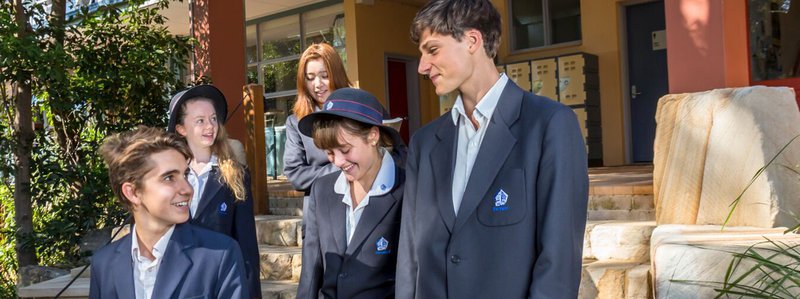
Welcome to Term 2!
Trent Zimmerman, MP for North Sydney, was a special visitor at our first assembly for the term. Trent was here to make two presentations:
• Sam Street of Class 6 won the Primary section of Trent’s North Sydney Speech Writing competition (as mentioned here last term) which drew 200 entries. Trent presented Sam with a certificate and book voucher, and congratulated him on his outstanding speech which Trent had read out in Parliament in March. He pointed out that Sam’s speech is now in Hansard and in the permanent record of Australia’s parliament.
• An Australian flag and an aboriginal flag as an official gift to the school from the Australian government.
We also acknowledged ANZAC day. History teacher David Alami gave an overview of Anzac day stressing the now universal and inclusive picture of what Anzac day means, and Year 11 students Ruby Vella and Nelson Hall-Whitington read a moving poem of a young soldier’s sacrifice, followed by a minute silence.
Ruby and Nelson accepted the flags on behalf of Glenaeon. Here is my response to the gift : (with photos)
Thank you Trent, for presenting us with this flag on behalf of the Australian government.
It’s particularly poignant to receive an aboriginal flag to fly on our flagpole here at Glenaeon. I say poignant because the aboriginal connection to this piece of Sydney’s Middle Harbour is so fragile. These lands of the Cammeraygal people bore the brunt of non-aboriginal settlement in 1788. This piece of land has the longest history of non-aboriginal settlement in all of Australia.
And as a result the land is silent to us. We know that every part of the Australian continent was once cared for and nurtured by aboriginal people. But not just cared for in a physical sense as dull material earth, but rather aboriginal people kept the land alive through their stories, songs and dances. We know that to aboriginal people, every creek, every rock outcrop, every valley, everything on the land, was the result of the work of the Ancestors in the Dreaming. The landscape held their stories and their songs.
The Songlines were the tracks of the ancestors as they travelled the land in the Dreaming, and at the end of the Dreaming the Ancestors lay down to sleep and their bodies now form the earth on which we live. This is Country, the land of the Ancestors. Every landscape was therefore a drama and held a story, and even a song which had to be sung by every generation descended from the Ancestors. This is what caring for the land meant.
I often wonder what the songs of our school land were? In Year 11 we teach a Main Lesson on Australia’s First Nations as a prelude to Year 11’s visit to MacFarlane Primary School in Katherine, NT and Kakadu, where our students work as classroom aides for the aboriginal children in the school. We learn about the Dreaming, and the Songlines, and look out on Scotts Creek and the beautiful valley that surrounds us. We wonder what the songs were that once made this valley come alive, what were the stories embedded in this landscape, which Ancestors once travelled through this part of Sydney Harbour?
But the land is now silent. Except for one thing: names. One way to start experiencing the aboriginal heritage is to appreciate the names of suburbs which carry a relic of aboriginal words. The people of this area were part of the Gu-Ring-Gai nation, speaking one language from the northern shore of Sydney harbour right up to the Hawkesbury river and into the Central Coast. Within that large nation there were particular clans, one of which was the Cammeraygal people who lived on our land here at Glenaeon. The suburb Cammeray is named after them. But most other names on the north shore are all English names either of places or of people planted on aboriginal land: Waverton, Wollstonecraft, Chatswood, Roseville, Lindfield, Gordon, Pymble.
What words do we have from the Gu-Ring-Gai?
• Kirribilli means a fishing spot.
• Killara means permanent, always there
• Turramurra means high place, big hill
• Warrawee means a resting place
• Wahroonga means our home
These are the only words we have from the Gu-Ring-Gai language, the names of a few suburbs.
Running through the North Shore is the Pacific Highway which is also a footprint. In the very first days after the First fleet landed, Captain Phillip noticed groups of aborigines walking up the hill across from Sydney Cove, what is now North Sydney and Crows Nest. He sent a young lieutenant to follow their trail, and the lieutenant marked the trees as they went. He found the trail ran right along the ridge top, and was a path leading right up to what was named the Hawkesbury river. In time, the path became a wagon track, then a road and now a highway. So when you drive up the Pacific Highway, remember you are actually driving on an aboriginal track.
These are the remains, the footprints of aboriginal people in our part of Sydney, a place that was once alive with aboriginal song and story, but is now silent to our ears.
Trent, this flag will mean a great deal to Glenaeon. The land may be silent, but we will fly the flag with pride, and may it always remind us that the land once sang, and of the aboriginal people who gave Country a voice.
Thank you!




